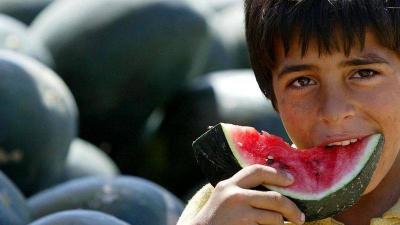Red, black, white, and green are not just the colors of watermelon but also the colors of the Palestinian flag. Thus, this symbolism can be seen around the world during pro-Palestinian marches and in countless social media posts amid the ongoing Israeli incursion in Gaza. However, there is a history behind this watermelon symbolism, detailed in a report by BBC Arabic.
After the war between Arabs and Israel in 1967, Israel took control of Gaza and the West Bank, banning the display of national symbols such as the Palestinian flag and its colors throughout the occupied territories. As carrying the flag became a crime, Palestinians began raising slices of watermelon instead of the flag as a form of protest.
Following the signing of a series of interim peace agreements between Israel and the Palestinians, known as the Oslo Accords in 1993, the flag was recognized as the flag of the Palestinian Authority, which was established to govern Gaza and parts of the occupied West Bank. New York Times journalist John Kifner noted after the signing of the Oslo Accords, "In Gaza, where young people used to be arrested for carrying watermelon slices to display the colors of the Palestinian flag—red, black, and green—soldiers stand by as parades wave the flag that was once banned."
A few months later, in December 1993, the newspaper clarified that the claims of arrests mentioned in the previous report could not be confirmed but added that "a spokesperson for the Israeli government, when asked about this matter, could not deny the possibility of such incidents occurring." Since then, artists have continued to create artworks using watermelon to express their solidarity with the Palestinians.
One of the most famous artworks is a painting by artist Khaled Hourani; in 2007, Hourani painted a piece for a book titled "The Self Atlas of Palestine," featuring a red watermelon slice. The painting, titled "The Watermelon Story," traveled around the world and gained more prominence during the Israel-Hamas conflict in May 2021. The story of the watermelon gained renewed fame earlier this year.
In January, Israeli National Security Minister Itamar Ben Gvir directed the police to remove Palestinian flags from public places, stating that waving them constitutes "support for terrorism," leading to the emergence of watermelon images during anti-Israeli protests. While Israeli law does not prohibit Palestinian flags, police and soldiers have the authority to remove them in situations where they perceive a threat to public order.
Recently, images of watermelons have spread across social media pages protesting the Gaza war. For instance, British Muslim comedian Shireen Nisa created watermelon filters on TikTok and encouraged her followers to make videos using them, pledging to donate all proceeds to charities supporting Gaza.
Pro-Palestinian users accused Instagram of implementing a "shadow ban" when the platform intervened to ensure certain posts did not appear in other users’ accounts. However, BBC digital security correspondent Joe Tidy stated that there is no evidence that this is currently happening, adding, "There does not seem to be any conspiracy to prevent users from posting pro-Palestine material. People are using watermelon images in their social media posts, and they freely use the Palestinian flag and write about the conflict publicly."
Watermelon has been regarded as a political symbol for decades in Palestine, especially during the first and second intifadas, and today many view watermelon not only as a popular fruit but also as a powerful symbol for generations of Palestinians and those who support their struggle.




